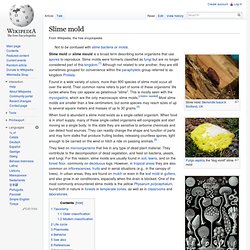

Mold. Mold growth covering a decaying peach.

The frames were taken approximately 12 hours apart over a period of six days. Spinellus fusiger growing on fungi Moldy tomatoes A mold (US) or mould (UK / NZ / AU / CA) is a fungus that grows in the form of multicellular filaments called hyphae.[1][2] In contrast, fungi that can adopt a single celled growth habit are called yeasts.
Molds are a large and taxonomically diverse number of fungal species where the growth of hyphae results in discoloration and a fuzzy appearance, especially on food.[3] The network of these tubular branching hyphae, called a mycelium, is considered a single organism. Molds cause biodegradation of natural materials, which can be unwanted when it becomes food spoilage or damage to property. Biology[edit] Molds reproduce by producing large numbers of small spores,[6] which may contain a single nucleus or be multinucleate. Common molds[edit] Food production[edit] The Kōji (麹?) Pharmaceuticals from molds[edit] Health effects[edit]
Slime mold. Mycetozoa from Ernst Haeckel's 1904 Kunstformen der Natur (Artforms of Nature) Found in a wide variety of colors, more than 900 species of slime mold occur all over the world.

Their common name refers to part of some of these organisms' life cycles where they can appear as gelatinous "slime". This is mostly seen with the myxogastria, which are the only macroscopic slime molds. [citation needed] Most slime molds are smaller than a few centimeters, but some species may reach sizes of up to several square meters and masses of up to 30 grams.[2] When food is abundant a slime mold exists as a single-celled organism. They feed on microorganisms that live in any type of dead plant material. Taxonomy[edit] Older classification[edit] Slime molds, as a group, are polyphyletic. Slime molds can generally be divided into two main groups. Modern classification[edit] In more strict terms, slime molds comprise the mycetozoan group of the amoebozoa. Slime mold (Physarum polycephalum) Life cycle[edit] Yeast. Yeasts, with their single-celled growth habit, can be contrasted with molds, which grow hyphae.

Fungal species that can take both forms (depending on temperature or other conditions) are called dimorphic fungi ("dimorphic" means "having two forms"). History In 1857, French microbiologist Louis Pasteur proved in the paper "Mémoire sur la fermentation alcoolique" that alcoholic fermentation was conducted by living yeasts and not by a chemical catalyst.[14][19] Pasteur showed that by bubbling oxygen into the yeast broth, cell growth could be increased, but fermentation was inhibited – an observation later called the "Pasteur effect".
By the late 18th century, two yeast strains used in brewing had been identified: Saccharomyces cerevisiae (top-fermenting yeast) and S. carlsbergensis (bottom-fermenting yeast). S. cerevisiae has been sold commercially by the Dutch for bread-making since 1780; while, around 1800, the Germans started producing S. cerevisiae in the form of cream. Ecology Uses Beer. Oomycete. Oomycota or oomycetes (oömycetes) form a distinct phylogenetic lineage of fungus-like eukaryotic microorganisms.

They are filamentous, microscopic, absorptive organisms that reproduce both sexually and asexually. Oomycetes occupy both saprophytic and pathogenic lifestyles – and include some of the most notorious pathogens of plants, causing devastating diseases such as late blight of potato and sudden oak death. They are also often referred to as water molds (or water moulds), although the water-preferring nature which led to that name is not true of most species, which are terrestrial pathogens.
Morphology[edit] The oomycetes rarely have septa (see hypha), and if they do, they are scarce,[1] appearing at the bases of sporangia, and sometimes in older parts of the filaments.[2] Some are unicellular, but others are filamentous and branching.[2] Phylogenetic relationships[edit] This relationship is supported by a number of observed differences in the characteristics of oomycetes and fungi.